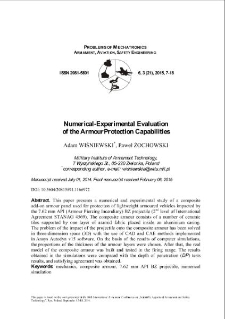Nasza Biblioteka Cyfrowa udostępnia 1 868 obiektów cyfrowych
Obiekt
Tytuł: Numerical-Experimental Evaluation of the Armour Protection Capabilities ; Numerical-Experimental Evaluation of the Armour Protection Capabilities
Współtwórca:
Paweł ŻOCHOWSKI ; Paweł ŻOCHOWSKI
Abstrakt:
This paper presents a numerical and experimental study of a compositea dd-on armour panel used for protection of lightweight armoured vehicles impacted by the 7.62 mm API (Armour Piercing Incendiary) BZ projectile (2nd level of International Agreement STANAG 4569). The composite armour consists of a number of ceramic tiles supported by one layer of aramid fabric placed inside an aluminium casing. The problem of the impact of the projectile onto the composite armour has been solved in three-dimension space (3D) with the use of CAD and CAE methods implemented in Ansys Autodyn v15 software. On the basis of the results of computer simulations, the proportions of the thickness of the armour layers were chosen. After that, the real model of the composite armour was built and tested in the firing range. The results obtained in the simulations were compared with the depth of penetration (DP) tests results, and satisfying agreement was obtained.
;
This paper presents a numerical and experimental study of a compositea dd-on armour panel used for protection of lightweight armoured vehicles impacted by the 7.62 mm API (Armour Piercing Incendiary) BZ projectile (2nd level of International Agreement STANAG 4569). The composite armour consists of a number of ceramic tiles supported by one layer of aramid fabric placed inside an aluminium casing. The problem of the impact of the projectile onto the composite armour has been solved in three-dimension space (3D) with the use of CAD and CAE methods implemented in Ansys Autodyn v15 software. On the basis of the results of computer simulations, the proportions of the thickness of the armour layers were chosen. After that, the real model of the composite armour was built and tested in the firing range. The results obtained in the simulations were compared with the depth of penetration (DP) tests results, and satisfying agreement was obtained.
Miejsce wydania:
Warszawa
;
Warszawa
Wydawca:
Wojskowa Akademia Techniczna ; Wojskowa Akademia Techniczna
Data utworzenia:
Data złożenia:
Data akceptacji:
Data wydania:
Rozmiar:
Identyfikator:
oai:ribes-88.man.poznan.pl:2253
Sygnatura:
doi:10.5604/20815891.1166972 ; doi:10.5604/20815891.1166972
ISSN elektroniczny:
ISSN drukowany:
Język:
Właściciel praw:
Wojskowa Akademia Techniczna ; Wojskowa Akademia Techniczna
Strona początkowa:
Strona końcowa:
Tom:
Słowa kluczowe:
mechanics, composite armour, 7.62 mm API BZ projectile, numerical simulation ; mechanics, composite armour, 7.62 mm API BZ projectile, numerical simulation
Kolekcje, do których przypisany jest obiekt:
Data ostatniej modyfikacji:
22 lip 2025
Data dodania obiektu:
22 lip 2025
Liczba wyświetleń treści obiektu:
0
Wszystkie dostępne wersje tego obiektu:
https://ribes-88.man.poznan.pl/publication/2549
Wyświetl opis w formacie RDF:
Wyświetl opis w formacie OAI-PMH:
| Nazwa wydania | Data |
|---|---|
| Numerical-Experimental Evaluation of the Armour Protection Capabilities | 22 lip 2025 |
Obiekty Podobne
Adam WIŚNIEWSKI Dawid PACEK
Adam WIŚNIEWSKI
Adam WIŚNIEWSKI Dawid PACEK
Adam WIŚNIEWSKI Łukasz TOMASZEWSKI
Adam WIŚNIEWSKI Paweł ŻOCHOWSKI
Adam WIŚNIEWSKI Dawid PACEK

